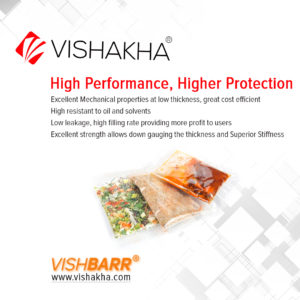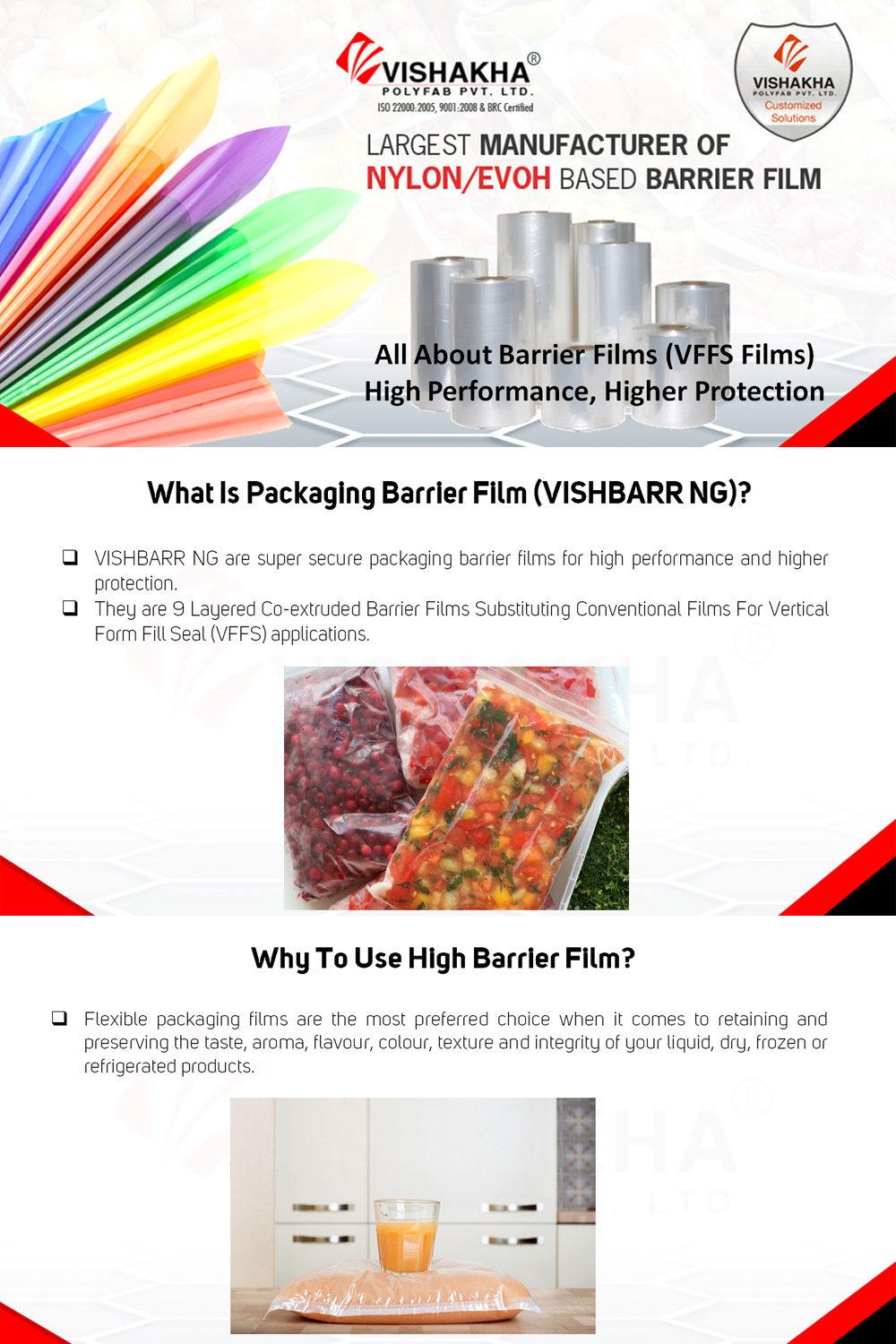September 2, 2024
Vertical Form Fill Seal (VFFS) machines have become a cornerstone in the packaging industry, offering a versatile and efficient solution for packaging a wide range of products, from food and beverages to pharmaceuticals and industrial goods. Central to the effectiveness of VFFS packaging is the use of barrier films, which protect the contents from external factors such as moisture, oxygen, and light. Over the years, barrier films have undergone significant evolution, driven by technological advancements and the need for more effective packaging solutions. This article delves into the historical development and technological improvements of barrier films used in VFFS machines, highlighting key innovations that have made these films more effective and efficient.
Historical Development of Barrier Films
The journey of barrier films in VFFS packaging began with simple, single-layer films that offered basic protection against moisture and light. These early films were primarily made from materials like polyethylene (PE) and polypropylene (PP), which provided a basic level of barrier protection but were limited in their effectiveness. As packaging needs grew more complex, the demand for better barrier properties led to the development of multi-layer films, which combined different materials to enhance the protective capabilities of the packaging.

Introduction of Multi-Layer Films
The first significant leap in barrier film technology came with the introduction of multi-layer films. These films were created by laminating or co-extruding multiple layers of different materials, each contributing specific properties such as strength, flexibility, or barrier protection. For example, a typical multi-layer film might consist of a layer of polyethylene for sealing, a layer of nylon for strength, and a layer of aluminum foil for an oxygen barrier.
This multi-layer approach allowed manufacturers to create films that offered superior protection against a range of environmental factors, significantly extending the shelf life of packaged goods. The use of aluminum foil, in particular, became widespread in the 1970s and 1980s due to its excellent barrier properties, especially against oxygen and moisture.
Technological Improvements in Barrier Films
As the demands of the packaging industry continued to evolve, so too did the technology behind barrier films. Several key innovations have played a crucial role in making these films more effective and efficient.
Nanocomposite Materials
One of the most groundbreaking advancements in barrier film technology has been the introduction of nanocomposite materials. These materials incorporate nanoparticles into the film matrix, which significantly enhances the barrier properties of the film without adding bulk or compromising flexibility.
Nanocomposites work by creating a tortuous path for gas molecules, making it much more difficult for oxygen, moisture, or other gases to penetrate the film. This innovation has allowed manufacturers to produce thinner films with superior barrier properties, reducing material costs and environmental impact while still providing excellent protection for the contents.
Multi-Layer Extrusion Techniques
Another major advancement has been in the field of multi-layer extrusion techniques. Traditional multi-layer films were often produced by laminating different layers together, which could be time-consuming and expensive. The development of multi-layer co-extrusion technology, however, allowed for the simultaneous extrusion of multiple layers in a single process.
This technique not only streamlined the production process but also enabled the creation of films with more precise control over layer thickness and composition. As a result, manufacturers could produce films with highly customized barrier properties tailored to the specific needs of different products, whether that meant enhanced oxygen barriers for food packaging or moisture barriers for pharmaceuticals.

Smart Barrier Properties
One of the most exciting recent developments in barrier film technology is the emergence of smart barrier properties. These films are designed to respond to environmental changes, such as temperature or humidity, by altering their barrier properties in real-time.
For instance, a smart barrier film might increase its oxygen barrier when exposed to higher temperatures, helping to protect the contents from spoilage during transportation or storage. This dynamic response capability offers significant advantages in ensuring product safety and extending shelf life, particularly for temperature-sensitive products like fresh produce or dairy items.
The Impact of Innovations on VFFS Packaging
The technological improvements in barrier films have had a profound impact on the effectiveness and efficiency of VFFS packaging. These innovations have not only enhanced the protective capabilities of the films but also improved the overall performance of VFFS machines, making them more versatile and cost-effective.
Enhanced Product Protection
The primary benefit of these advancements is the enhanced protection they offer to packaged goods. With the introduction of nanocomposites and multi-layer extrusion techniques, barrier films can now provide superior protection against oxygen, moisture, light, and other environmental factors. This has led to a significant increase in the shelf life of many products, particularly perishable goods like food and beverages.
For example, the use of nanocomposite films in food packaging can prevent oxygen from penetrating the packaging, reducing the risk of oxidation and spoilage. Similarly, multi-layer films with enhanced moisture barriers are essential for products like snacks and cereals, which need to remain dry and crisp.
Improved Machine Efficiency
The innovations in barrier film technology have also led to improvements in the efficiency of VFFS machines. Thinner, stronger films are easier to handle and require less energy to seal, which can lead to faster packaging speeds and lower production costs. The development of co-extruded films, in particular, has streamlined the packaging process, reducing the need for additional steps like lamination.
Additionally, the versatility of modern barrier films means that VFFS machines can be used to package a wider range of products, from dry goods to liquids, without the need for significant modifications to the machine. This adaptability has made VFFS packaging an even more attractive option for manufacturers looking to optimize their production lines.
Environmental Benefits
The move towards thinner, more efficient barrier films has also had positive environmental implications. By reducing the amount of material required to create effective barrier films, manufacturers are able to lower their carbon footprint and reduce waste. Furthermore, the development of recyclable and biodegradable films is helping to address the growing demand for sustainable packaging solutions.
The Future of Barrier Films in VFFS Packaging
Looking ahead, the future of barrier films in VFFS packaging is likely to be shaped by ongoing advancements in materials science and technology. The continued development of smart barrier properties, in particular, holds great promise for creating packaging solutions that are not only more effective but also more adaptable to changing conditions.
We can also expect to see further innovations in sustainable packaging, with a growing emphasis on creating barrier films that are both highly effective and environmentally friendly. As consumers and regulators increasingly prioritize sustainability, the packaging industry will need to continue evolving to meet these demands.
Conclusion
The evolution of barrier films in VFFS packaging has been marked by significant technological advancements, from the early days of simple single-layer films to today’s sophisticated multi-layer and nanocomposite solutions. These innovations have made barrier films more effective and efficient, enhancing product protection, improving machine efficiency, and offering environmental benefits. As the packaging industry continues to evolve, the ongoing development of barrier films will play a crucial role in meeting the needs of manufacturers and consumers alike, ensuring that products remain safe, fresh, and appealing throughout their shelf life.

